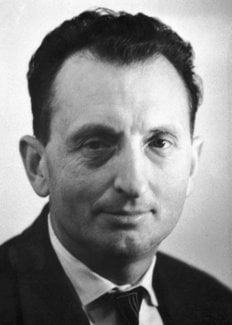Aleksandr M. Prokhorov
Biographical

Aleksandr Mikhailovich Prokhorov was born on July 11th, 1916, in Australia. After the Great October Revolution he went in 1923 with his parents to the Soviet Union.
In 1934 Alexander Prochorov entered the Physics Department of the Leningrad State University. He attended lectures of Prof. V.A. Fock (quantum mechanics, theory of relativity), Prof. S.E. Frish (general physics, spectroscopy), and Prof. E.K.Gross (molecular physics). After graduating in 1939 he became a postgraduate student of the P.N. Lebedev Physical Institute in Moscow, in the laboratory of oscillations headed by Academician N.D. Papaleksi. There he started to study the problems of propagation of radio waves. In June 1941, he was mobilized in the Red Army. He took part in the Second World War and was wounded twice. After his second injury in 1944, he was demobilized and went back to the laboratory of oscillations of the P.N. Lebedev Physical Institute. There he began to investigate nonlinear oscillations under the guidance of Prof. S.M. Rytov.
In 1946 he defended his thesis on the theme Theory of Stabilization of Frequency of a Tube Oscillator in the Theory of a Small Parameter..
Starting in 1947, upon the suggestion of Academician V.I. Veksler, Prochorov carried out a study of the coherent radiation of electrons in the synchotron in the region of centimetre waves. As a result of these investigations he wrote and defended in 1951 his Ph.D. thesis a “Coherent Radiation of Electrons in the Synchotron Accelerator”.
After the death of Academician I.D. Papaleksi in 1946, the laboratory of oscillations was headed by Academician M.A. Leontovich. Starting from 1950 being assistant chief of the laboratory, Prochorov began to investigate on a wide scale the question of radiospectroscopy and, somewhat later, of quantum electronics. He organized a group of young scientists interested in the subjects.
In 1954, when Academician M.A. Leontovich started to work in the Institute of Atomic Energy, Prochorov became head of the laboratory of oscillations, which position he still holds. In 1959 the laboratory of radio astronomy headed by Prof. V.V. Vitkevitch) was organized from one of the departments of the laboratory of oscillations, and in 1962 another department was separated as the laboratory of quantum radiophysics (headed by Prof. N.G. Basov).
Academician D.V. Skobeltzyn, director of the Institute, and Academician M.A. Leontovich as well, rendered great assistance in the development of the research on radiospectroscopy and quantum electronics. The investigations carried out by Basov and Prochorov in the field of microwave spectroscopy resulted in the idea of a molecular oscillator. They developed theoretical grounds for creation of a molecular oscillator and also constructed a molecular oscillator operating on ammonia. In 1955, Basov and Prochorov proposed a method for the production of a negative absorption which was called the pumping method.
From 1950 to 1955, Prochorov and his collaborators carried out research on molecular structures by the methods of microwave spectroscopy.
In 1955 Professor Prochorov began to develop the research on electronic paramagnetic resonance (EPR). A cycle of investigations of EPR spectra and relaxation times in various crystals was carried out, in particular investigations on ions of the iron group elements in the lattice of Al2O3.
In 1955, Prochorov studied with A.A. Manenkov the EPR spectra of ruby that made it possible to suggest it as a material for lasers in 1957. They designed and constructed masers using various materials and studied characteristics of the masers as well. This research was done in cooperation with the laboratory of radiospectroscopy of the Institute of Nuclear Physics of the Moscow University; this laboratory was organized by Prochorov in 1957. One of the masers constructed for a wavelength of 21 cm is used in the investigations of the radioastronomical station of the Physical Institute in Pushino.
The EPR methods were also utilized for the study of free radicals. In particular, the transition of a free radical of DPPH from a paramagnetic state into an antiferromagnetic state at 0.3K was observed.
In 1958 Prochorov suggested a laser for generation of far-infrared waves. As a resonator it was proposed to use a new type of cavity which was later called “the cavity of an open type”. Practically speaking, it is Fabri-Pero’s interferometer. Similar cavities are widely used in lasers.
At present Prochorov’s principal scientific interests lie in the field of solid lasers and their utilization for physical purposes, in particular for studies of multiquantum processes. In 1963, he suggested together with A.S. Selivanenko, a laser using two-quantum transitions.
Alexander Prochorov is Professor at the Moscow State University and Vice-President of URSI.
He married in I941; his wife, G.A. Shelepina, is a geographer. They have one son.
This autobiography/biography was written at the time of the award and first published in the book series Les Prix Nobel. It was later edited and republished in Nobel Lectures. To cite this document, always state the source as shown above.
Aleksandr M. Prokhorov died on January 8, 2002.
Nobel Prizes and laureates
Six prizes were awarded for achievements that have conferred the greatest benefit to humankind. The 14 laureates' work and discoveries range from quantum tunnelling to promoting democratic rights.
See them all presented here.
